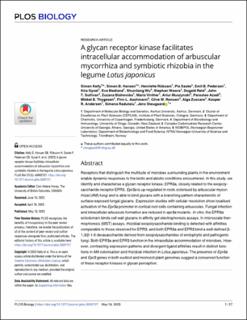| dc.contributor.author | Kelly, Simon | |
| dc.contributor.author | Hansen, Simon B. | |
| dc.contributor.author | Rübsam, Henriette | |
| dc.contributor.author | Saake, Pia | |
| dc.contributor.author | Pedersen, Emil B. | |
| dc.contributor.author | Gysel, Kira | |
| dc.contributor.author | Madland, Eva | |
| dc.contributor.author | Wu, Shunliang | |
| dc.contributor.author | Wawra, Stephan | |
| dc.contributor.author | Reid, Dugald | |
| dc.contributor.author | Sullivan, John T. | |
| dc.contributor.author | Blahovska, Zuzana | |
| dc.contributor.author | Vinther, Maria | |
| dc.contributor.author | Muszynski, Artur | |
| dc.contributor.author | Azadi, Parastoo | |
| dc.contributor.author | Thygesen, Mikkel B. | |
| dc.contributor.author | Aachmann, Finn Lillelund | |
| dc.contributor.author | Ronson, Clive W. | |
| dc.contributor.author | Zuccaro, Alga | |
| dc.contributor.author | Andersen, Kasper R. | |
| dc.contributor.author | Radutoiu, Simona | |
| dc.contributor.author | Stougaard, Jens | |
| dc.date.accessioned | 2023-11-08T07:03:58Z | |
| dc.date.available | 2023-11-08T07:03:58Z | |
| dc.date.created | 2023-06-16T08:45:44Z | |
| dc.date.issued | 2023 | |
| dc.identifier.issn | 1544-9173 | |
| dc.identifier.uri | https://hdl.handle.net/11250/3101241 | |
| dc.description.abstract | Receptors that distinguish the multitude of microbes surrounding plants in the environment enable dynamic responses to the biotic and abiotic conditions encountered. In this study, we identify and characterise a glycan receptor kinase, EPR3a, closely related to the exopolysaccharide receptor EPR3. Epr3a is up-regulated in roots colonised by arbuscular mycorrhizal (AM) fungi and is able to bind glucans with a branching pattern characteristic of surface-exposed fungal glucans. Expression studies with cellular resolution show localised activation of the Epr3a promoter in cortical root cells containing arbuscules. Fungal infection and intracellular arbuscule formation are reduced in epr3a mutants. In vitro, the EPR3a ectodomain binds cell wall glucans in affinity gel electrophoresis assays. In microscale thermophoresis (MST) assays, rhizobial exopolysaccharide binding is detected with affinities comparable to those observed for EPR3, and both EPR3a and EPR3 bind a well-defined β-1,3/β-1,6 decasaccharide derived from exopolysaccharides of endophytic and pathogenic fungi. Both EPR3a and EPR3 function in the intracellular accommodation of microbes. However, contrasting expression patterns and divergent ligand affinities result in distinct functions in AM colonisation and rhizobial infection in Lotus japonicus. The presence of Epr3a and Epr3 genes in both eudicot and monocot plant genomes suggest a conserved function of these receptor kinases in glycan perception. | en_US |
| dc.language.iso | eng | en_US |
| dc.publisher | Public Library of Science, PLOS | en_US |
| dc.rights | Navngivelse 4.0 Internasjonal | * |
| dc.rights.uri | http://creativecommons.org/licenses/by/4.0/deed.no | * |
| dc.title | A glycan receptor kinase facilitates intracellular accommodation of arbuscular mycorrhiza and symbiotic rhizobia in the legume Lotus japonicus | en_US |
| dc.title.alternative | A glycan receptor kinase facilitates intracellular accommodation of arbuscular mycorrhiza and symbiotic rhizobia in the legume Lotus japonicus | en_US |
| dc.type | Peer reviewed | en_US |
| dc.type | Journal article | en_US |
| dc.description.version | publishedVersion | en_US |
| dc.source.volume | 21 | en_US |
| dc.source.journal | PLoS Biology | en_US |
| dc.source.issue | 5 | en_US |
| dc.identifier.doi | 10.1371/journal.pbio.3002127 | |
| dc.identifier.cristin | 2155128 | |
| dc.source.articlenumber | e3002127 | en_US |
| cristin.ispublished | true | |
| cristin.fulltext | original | |
| cristin.qualitycode | 2 | |

